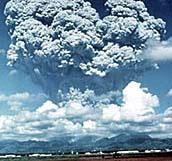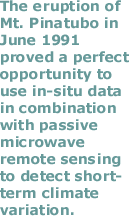

 |
by Rachel Hauser May 2, 2000 |
||
|
Typically, climate change is a process that happens gradually, with noticeable impacts occurring over a long span of time. In areas that are sensitive to change, however, climate variability is being noticed on much shorter time scales. Satellite remote sensing techniques allow researchers access to areas where such climatic sensitivities are otherwise difficult to monitor on a routine basis. Greenland is one such area.
|
 Volcanic ash cloud from Mt. Pinatubo, on June 12, 1991. Three days later, it exploded in the second largest volcanic eruption of the century. (Image courtesy of U.S. Geological Survey) 
For more information, visit the National Snow and Ice Data Center DAAC and the Goddard Space Flight Center DAAC (now named the GSFC Earth Sciences DAAC). (A new browser window will open.) |
Recently, researchers have linked a cooling anomaly in Greenland's melting trend to the eruption of Mt. Pinatubo. The volcano loaded the atmosphere with debris and sulfur dioxide, reducing incoming radiation and consequently, global temperatures.
The limited number of in-situ observations could not have confirmed this cooling trend. To correlate melt extent with available empirical data, Konrad Steffen, University of Colorado professor, and Waleed Abdalati, research scientist at NASA/Goddard Space Flight Center, developed a method to estimate the onset of seasonal snow melt using satellite remote sensing data. Steffen and Abdalati have carried out research on the Greenland Ice Sheet since 1990 and 1993, respectively. Its remoteness and expansive size limited their ability to monitor the entire ice sheet. Consequently, to obtain an idea about sheet-wide melt, it was necessary to devise a means of monitoring melt on a large scale. By comparing in-situ melt measurements to data from coincident satellite overpasses, it was possible to devise an algorithm for melt detection which is applicable to the entire ice sheet. In this way, large spatial and temporal-scale melt information is extracted from measurements at a single location. Their method of determining melt thresholds incorporates passive microwave satellite data obtained from two different channels. One channel has a longer wavelength than the other and is more strongly affected by changes in snow water content. Using the (normalized) difference between the two microwave channels, Steffen and Abdalati are able to determine melt onset. The eruption of Mt. Pinatubo in June 1991 proved a perfect opportunity to use in-situ data in combination with passive microwave remote sensing to detect short-term climate variation. "When the snow is dry, energy is emitted from the top few meters of snow. Energy is lost due to the scattering in the volume of snow from which it is emitted," said Abdalati. "Since emission occurs through a volume, more energy is scattered or lost than if it was emitted at the surface only. When snow gets wet, the gaps between the snow grains begin to fill, and the grains become rounded by the water film on the surface. As a result, most of the [energy] emission is from the snow surface, approximately the top 5-10 cm, and scattering is minimal." The impact of the Greenland Ice Sheet on global and regional climate is tremendous, according to Steffen. The high albedo of the land ice sheet causes a huge return of energy back to the atmosphere. Little of the incoming radiation is stored. "Because the net radiation is negative, the areal extent and duration of snow cover plays an important climatological role," said Steffen. The geography of Greenland is an important factor in snow and ice melt. Due to the large size and shallow slope of the ice sheet, small changes in air temperature lead to large changes in the melt area extent. Summer melt is measured on an annual basis at the University of Colorado's Greenland camp. The next step for Steffen and Abdalati is to use their model to verify that the 1992 mean melt extent was indeed an anomaly by monitoring subsequent melt seasons. |
|